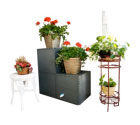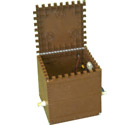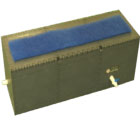My roof is pretty small. Is it worth it for me use a RainReserve Diverter Kit?
Generally speaking, yes. One inch of rain on a 1000-square-foot roof will generate about 600 gallons of runoff. To calculate the amount of water that will run off your roof during an average rainfall, multiply the square footage of your roof by 600, then divide by 1000. Most barrels are 55 gallons, and they fill surprisingly quickly in a decent rain.
Are there ways to disguising rain barrels?
In order to ensure your barrel does not affect the aesthetic of your home's exterior, we recommend placing chicken wire around the barrel and training one of many native vining plant to grow up the wire. Another option is to build an aesthetically pleasing rain barrel enclosure. Finally you can place the barrel among bushes/shrubs to disguise your rain barrels. The possibilities are endless.
Can I drink the water from my rain barrel?
While the rain water you collect in your barrel may potentially be suitable for livestock drinking water, it is not intended for human consumption. However, we are in the process of developing advanced filtration systems to further purify the water.
When should I disconnect my rain barrel in the fall and reconnect it in the spring?
You should disconnect your rain barrel before the first hard freeze. If you empty all water out of your barrel, you can keep it attached for a few additional weeks; just make sure you are completely emptying it every time it fills. You should wait until the first good rain of the springtime has fallen before reattaching your rain barrel. The first good rain should flush considerably more debris from the roof and gutters than subsequent rains. Attaching your rain barrel before this point may increase the chances of clogging the diverter.
What happens when my rain barrel is full?
When your rain barrel is full, rainwater will be re-directed through the RainReserve Diverter and back to your gutter.
How do I clean the inside of the rain barrel?
We recommend washing the barrel when disconnecting it for the season. Use an environmentally friendly solution of 2 tsp. of castile soap + 2 tsp. vinegar or lemon juice per gallon of water for cleaning, swishing the solution around inside the barrel then rinsing the inside of the barrel with a garden hose. A concentrated spray nozzle will work well to remove residue from the inside of the barrel.
Why is storm water bad for lakes and other natural bodies of water?
It isn't the water that falls directly from the sky onto the lakes that is the problem—it is the storm water that runs over impervious surfaces and ends up flowing into the lakes fast, hot and dirty. It can pick up pet and livestock waste, fertilizers, pesticides, detergents, trash, invasive plant seeds, automotive liquids like motor oil, antifreeze, brake fluid, leaves, grass clippings and more. All of these elements have detrimental effects on the quality of the water in lakes, rivers, streams and oceans.
Can I introduce the supply of water I acquire in my rain barrel into my home or business plumbing?
It is possible to utilize water from your rain barrel for certain home or business water needs (e.g. toilets) but it may be a complex process that requires professional installation.
Can I have someone install the RainReserve Rain Barrel Diverter Kit for me?
Yes, a local professional may be able to assist you in getting your RainReserve Diverter up and running. We recommend you call your local gutter installation company to determine whether or not this is a possibility, and we are currently working towards developing a network of local installation experts.
What kind of barrel do I have to use?
Any closed tank (metal or plastic) of any size and shape will serve as an adequate container to collect the rain water. If you are reusing a container from any factory or manufacturer, please keep in mind that the barrel must be a food-grade container and must not have contained harmful chemicals during any of its prior functions or uses.
Can I add more than two barrels?
Yes, you can add virtually unlimited barrels using the Connector Kit.
Can I utilize the water in my barrel with a soaker hose?
Yes, simply thread the hose onto the high-flow spigot.
Can I hook up my sprinkler to the system?
RainReserve is constantly looking for ways to improve the functionality and expand the uses for rain barrel water. While at this time it is not possible to utilize the water with a sprinkler, we are working on a pressurization system to meet that need.
How much water do I need?
This depends on how much rain you get in your part of the country. Arizona gets .7 in per month on average. California about an 1.5. Places like Georgia, New York, and WI get about 4, 3.3, and 2.6 inches of rain a month. This number varies tremendously depending on season, drought, and flooding. Never the less, this means that on a 1000 square foot roof and 1 inch of rain you have the potential to catch 623 gallons. In Arizona you could catch almost 430 gallons a month and in Georgia you could keep nearly 2492 gallons.
Now you must decide how much plant life and how much water you intend to use for other uses, like washing your car or flushing your toilets. An average household of 4 can use around 12,000 gallons a month for bathing, cooking, washing, recreation and watering. Outdoor use could account for as much as 40% of the monthly usage. The best use for unfiltered, but soft distilled water is for outside use on plants, gardens and washing your car.
So the answer is, as much as possible, but saving any amount will help you get through a drought, local water restrictions or power outages and the chance of scarce or a complete lack of water. With this in mind consider the RainReserve multiple rain barrel system. You decide how much you want to start off with, be it 55 gallons per downspout or 1000 gallons per downspout. The RainReserve is a diverter and barrel system that allows 1 or 2 tanks to be filled in parallel. If you wanted to save more water, the Daisy Chain Kit can be added and allows for limitless expansion or additional systems could be added to multiple rain barrels on downspouts around the house.
How much money do you want to spend?
When pricing out a rain saving system, the investment is with the tank or barrel. Large tanks can cost as much as $2,000 (not including shipping) for 1000 gallon tanks that can be buried underground. The other extreme is recycled industrial 55 gallon barrels that can cost anywhere from $25 to $7 or even free if you already have a source. The cost range for tanks and barrels is huge.
The important thing to remember is how are you going to get the rain in the tank. The RainReserve System, works with any type of tank. Which means, use the RainReserve System for any size budget.
What do you do with the overflow?
This is very important to consider. When your rain barrel or tank fills up, which, it will. Where is the rest of the water from your roof going to go? You probably have already invested a lot of money in grading the landscape, drainage pipes, or some type of predetermined path away from your basement and foundation before you planned on your mutliple rain barrel system. Most of the systems on the market, have overflow tubes that come out the side or just overflow over the top. The danger is, that this water could seep into the basement, create a hazard on a patio or could ruin your landscape. Even if the system has an overflow tube at the barrel, then, ask yourself, then what do you do with it, and hopefully it is large enough to dispense enough water during severe weather.
The RainReserve System uses an automatic, closed system technology where, when the water fills the rain barrels, the water is then diverted back to your existing drainage system in the downspout and in the drainage pipes or wherever you use to have the water go, when you didn’t have any problems. By easily inserting the small diverter into the downspout you are in fact not changing your whole water drainage plan, but just tapping the useful water out for later use. The RainReserve Diverter was also designed with a non-constricting, open flow system, where the fail-safe mode during severe storms and rains up to 3 to 5 inches per hour allows the house’s drainage system to work as it was meant for.
What kind of gutter do I have?
What I have found, as I have traveled across the country, is that the majority of houses have a standard 2” x 3” downspout. Much of the new construction and larger residential homes have a standard 3”x 4” downspout. There are small percentages of urban and older houses that have round or custom unique shapes. This is extremely easy to figure out, if you don’t already know. Just look at them and measure them with a ruler.
The RainReserve was designed to work with the standard 2” x 3” and the 3” x 4” downspouts. The open Diverter design can withstand the added volume of the 3” x 4” downspout without constricting the existing system. As for the other custom downspouts, a custom solution is required by the installer. (Don’t worry, we are working on the last percentage of custom downspouts.)
When do I get ROI (return on investment)?
This obviously this depends on how much you have invested. Consider how much money you have invested in your landscape, garden, and a nice paint job on your car. Now add the price of your system, and figue out when you will get your money back. Municipal water is extremely cheap. On average around $0.004 per a gallon. Not even half of a penny. With growing infrastructure, increasing energy costs, and depletion of our water sources, this can easily go up from there.
The calculation for when you get your money back for the use of water is going to be a long time if you don’t consider your dying landscape or the price of not being able to flush your toilets. The best way to compare the market is price per gallon for the first time it rains and fills up the tank.
For example a dedicated rainwater harvesting system can cost as much as $15,000 for 10,000 gallons. When this fills you are at $1.50 per gallon. If you a buy a standard rain barrel you might pay around $100 for 65 gallons. Now you’re at $1.53 a gallon. The RainReserve system can potentially be set up with two used 275 gallon totes for about $70 a piece. With a total investment of $140 for the tanks and 108.99 for the Double Capacity RainReserve System the total investment is 248.99, giving you a total of about $0.43 per a gallon.
How am I going to use it?
Chances are you are going to be using it for outdoor uses. The most flexible way is with a centrifugal pump on the outlet on the tank for water devices that require pressure; sprinklers, hose with a spray nozzle and pressure irrigation systems. If you don’t wire it with electricity or have a pump handy, a gravity fed system can be just as effective.
The Complete RainReserve System comes with a ball valve with garden hose threads. Using this type of spigot has a very minimal pressure drop and has 2 to 3 times the flow rate of a common brass spigot with a twist handle. This means you can fill a 5 gallon pail in about 30 seconds. This can be faster than your regular well or municipal system. One of the most efficient methods is with a soaker hose routed through the garden or landscape. This maximizes the water intake by the plants and minimizes the waste water. We recommend soaker hoses with larger holes to prevent the pores of the hose of getting blocked by fine dust and dirt. Gravity fed systems work best if elevated a minimum of 8 in. Placing it higher will improve usability, but will have a negligible effect on pressure until you get about 40 feet high. (Don’t forget water is very heavy, and your roof must be higher than 40 feet)
Where am I going to put it?
The question is actually where are you going to need it. Landscaping on the corner of the house, garden in the yard, or close to the driveway for your car. Many systems can be centralized but require a pump to move the water around. With a gravity fed system, elevate the barrel or tank and keep close to your point of use.
The RainReserve System is most efficient, if it utilizes multiple downspout around your house for all the different uses you might have. This also prevents carrying a hose around the house and adds a water spigot of free water at every downspout, which would be a tough plumbing job for well or municipal water systems.
Depending on each situation, Home owner Associations and the design of your landscape might prevent you from putting the barrel directly under the downspout. A RainReserve kit comes with 5 feet of tubing to allow for placing the barrel around the corner, out of site under the deck, or even underground.
What are you going to use it for?
When you have saved your soft distilled rainwater, there are few things to consider when deciding how to use it. Plants love this, nitrogen rich, source of water much more than the shockingly cold water from a well with calcium and other hard elements or the chlorine, fluoride treated water from the grid. On the other hand people are not accustomed to drinking this water unfiltered or treated. Making rainwater drinkable is a tricky subject that depends on where you live, what kind of roof you have and what type of post filtration process you are going to use. There are filtration systems on the market that can make this water potable, but requires more investment, electricity, and probably a professional install. Go for it!
What are you going to do about mosquitos, thirsty critters, and an open water hazard?
Since water is the essence of life, many bugs, four legged creatures and who knows what else will be gravitating towards this new source of water. Systems on the market deal and don’t deal with this concern in different ways. The simplest system, an open barrel or tank can be a breeding ground for mosquitos, a suicide tank for mice and squirrels, and could potentially be a danger to young kids. A screen on top can minimize mosquitos, but does not address the open water hazard. “Mosquito Dunks” work well if you remember to use them and always have them on hand.
The RainReserve System is a completely closed system, where nothing can get into the tank except for rain and air. There are no accidental drowning, and the bugs and animals don’t even know that there is water there.
How do you get rid of the leaves, pine needles, and other dirt on your roof?
In most situations, it is inevitable that debris will land on your roof. When it rains, the debris will travel down your gutters and through your downspout. Most of the systems on the market will deal with this with a screen or mesh on the top of the barrel. This will require cleaning on a regular basis to make sure that the water enters the barrel correctly. This could be a potential failure point, of many systems if not attended to.
The RainReserve’s open Diverter design allows the debris to fall straight though the downspout. Leaves and the larger debris will end up in your yard. Finger like protrusions surround the outlet to the barrel, to prevent smaller debris like the pine needles, from going in your tank. Like all systems, some maintenance is required. The diverter has an access door that slides up to inspect and clean out the debris.













